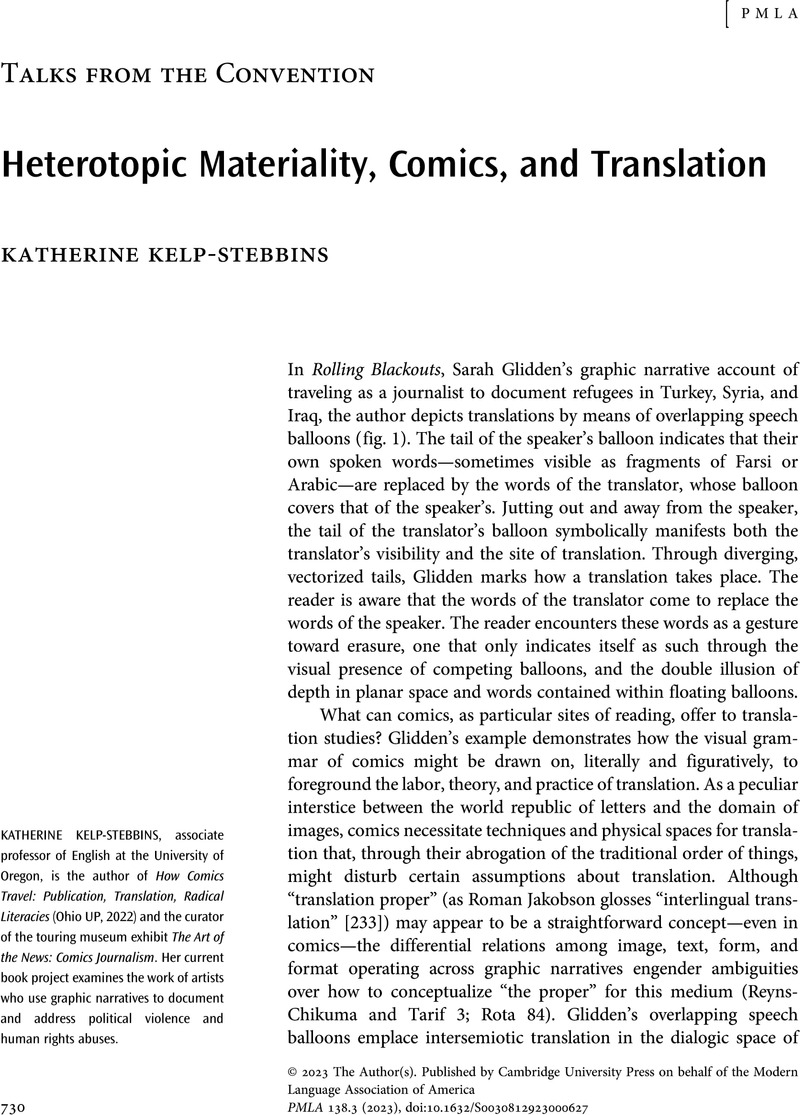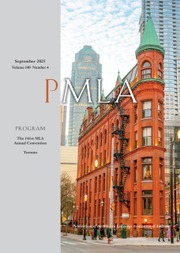No CrossRef data available.
Article contents
Heterotopic Materiality, Comics, and Translation
Published online by Cambridge University Press: 12 September 2023
Abstract
An abstract is not available for this content so a preview has been provided. Please use the Get access link above for information on how to access this content.

Information
- Type
- Talks from the Convention
- Information
- Copyright
- Copyright © 2023 The Author(s). Published by Cambridge University Press on behalf of the Modern Language Association of America
References
Works Cited
Baudry, Julien. “Paradoxes of Innovation in French Digital Comics.” The Comics Grid: Journal of Comics Scholarship, no. 8, 2018, p. 4, https://doi.org/10.16995/cg.108.CrossRefGoogle Scholar
Davies, Dominic. Urban Comics: Infrastructure and the Global City in Contemporary Graphic Narratives. Routledge, 2019.CrossRefGoogle Scholar
di Ricco, Massimo. “Drawing for a New Public: Middle Eastern 9th Art and the Emergence of a Transnational Graphic Movement.” Postcolonial Comics: Texts, Events, Identities, edited by Mehta, Binita and Mukherji, Pia, Routledge / Taylor and Francis, 2014, pp. 187–203.Google Scholar
Douglas, Allen, and Malti-Douglas, Fedwa. Arab Comic Strips: Politics of an Emerging Mass Culture. Indiana UP, 1994.Google Scholar
Drucker, Johanna. “Visual Performance of the Poetic Text.” Close Listening: Poetry and the Performed Word, edited by Bernstein, Charles, Oxford UP, 1998, pp. 131–61.Google Scholar
Drucker, Johanna. “What Is Graphic about Graphic Novels?” English Language Notes, vol. 46, no. 2, 2008, pp. 39–55.CrossRefGoogle Scholar
Emmerich, Karen. Literary Translation and the Making of Originals. Bloomsbury, 2017.CrossRefGoogle Scholar
Foucault, Michel. Les mots et les choses: Une archéologie des sciences humaines. Éditions Gallimard, 1966.Google Scholar
Foucault, Michel. “Of Other Spaces (1967).” Heterotopia and the City: Public Space in a Postcivil Society, edited and translated by Michiel Dehaene and Lieven De Cauter, Routledge, 2008, pp. 13–29.Google Scholar
Foucault, Michel. The Order of Things: An Archaeology of the Human Sciences. Translated by Sheridan, Alan, Vintage, 1994.Google Scholar
Fresnault-Deruelle, Pierre. “From Linear to Tabular.” The French Comics Theory Reader, edited and translated by Miller, Ann and Beaty, Bart, Leuven UP, 2014, pp. 121–38.Google Scholar
Gabai, Anna. “Samandal: Comics from Lebanon.” Rivista degli studi orientali, no. 87, supp. 1, 2014, pp. 95–101, https://doi.org/10.1400/234708.Google Scholar
Genette, Gérard. Narrative Discourse: An Essay in Method. Translated by Lewin, Jane E., Cornell UP, 1980.Google Scholar
Glidden, Sarah. Rolling Blackouts: Dispatches from Turkey, Syria, and Iraq. Drawn and Quarterly, 2016.Google Scholar
Goodbrey, Daniel Merlin. “Digital Comics—New Tools and Tropes.” Studies in Comics, vol. 4, no. 1, 2013, pp. 185–97.CrossRefGoogle Scholar
“Grants/Samandal: Publishing Comics Online in Three Languages Under CC Licenses.” Creative Commons Wiki, 30 June 2010, wiki.creativecommons.org/wiki/Grants/Samandal_:_Publishing_Comics_Online_in_Three_Languages_Under_CC_Licenses.Google Scholar
Groensteen, Thierry. “Definitions.” The French Comics Theory Reader, edited and translated by Miller, Ann and Beaty, Bart, Leuven UP, 2014, pp. 93–114.Google Scholar
Groensteen, Thierry. The System of Comics. Translated by Beaty, Bart and Nguyen, Nick, UP of Mississippi, 2007.Google Scholar
Guyer, Jonathan. “From Beirut: The Origin Story of Arab Comix.” Institute of Current World Affairs, 9 Sept. 2015, www.icwa.org/from-beirut-the-origin-story-of-arab-comix/.Google Scholar
Hamouche, Nicole. Raphaëlle Macaron: In Her Own Words. Friedrich Naumann Stiftung, 11 Dec. 2020, www.freiheit.org/lebanon/women-lebanon-raphaelle-macaron. The Women of Lebanon.Google Scholar
Hatfield, Charles. Alternative Comics: An Emerging Literature. UP of Mississippi, 2005.Google Scholar
Hayek, Ghenwa. “Past, Present, and Future Violence in Lebanese Comics.” Interview by Yishu Deng. Arab Media and Society, 15 Jan. 2017, www.arabmediasociety.com/interview-past-present-and-future-violence-in-lebanese-comics/.Google Scholar
Henoud, Carla. “Raphaëlle Macaron, la BD comme un rêve.” L'Orient–Le Jour, 24 Mar. 2018, www.lorientlejour.com/article/1106824.Google Scholar
Hirohito, Miyamoto, and Prough, Jennifer. “The Formation of an Impure Genre—on the Origins of ‘Manga.’” Review of Japanese Culture and Society, vol. 14, 2002, pp. 39–48. JSTOR, www.jstor.org/stable/42800200.Google Scholar
Imam, Hatem. “Hatem Imam in Conversation with Huda Smitshuijzen AbiFarès.” Interview by Huda Smitshuijzen AbiFarès. Khatt Chronicles: Stories on Design from the Arab World, episode 1, www.khtt.net/en/page/29877/hatem-imam-studio-safar-in-conversation-with-huda-smitshuijzen.Google Scholar
Imam, Hatem. “Tongue-Tied—the Evasiveness of Language in Today's ‘Arab’ Comics.” ArteEast: The Global Platform for Middle East Arts, summer 2008, arteeast.org/quarterly/summer-2008-tongue-tied/.Google Scholar
Jakobson, Roman. “On Linguistic Aspects of Translation.” On Translation, edited by Brower, Reuben, Harvard UP, 1959, pp. 232–39.Google Scholar
Kaï, Joseph. “Joseph Kaï (Collectif Samandal): ‘Les BD de Samandal sont à cheval entre deux mondes.’” Interview by Didier Pasamonik. ActuaBD, 13 Mar. 2018, www.actuabd.com/Joseph-Kai-Collectif-Samandal-les-BD-de-Samandal-sont-a-cheval-entre-deux.Google Scholar
Kashtan, Aaron. Between Pen and Pixel: Comics, Materiality, and the Book of the Future. Ohio State UP, 2018.CrossRefGoogle Scholar
Kelp-Stebbins, Katherine. “Comics as Orientation Devices.” Comics Studies Here and Now, edited by Aldama, Frederick Luis, Routledge, 2018, pp. 211–25.CrossRefGoogle Scholar
Khouri, Omar. “An Interview with Omar Khouri.” Zoom interview. Conducted by the author and Debarghya Sanyal, 27 July 2021. YouTube, www.youtube.com/watch?v=0GBUytoNv4g.Google Scholar
Khoury, Gilles. “Samandal, le temple de la BD libanaise, voit l'utopie en technicolor.” L'Orient–Le Jour, 3 Nov. 2017, www.lorientlejour.com/article/1081853.Google Scholar
Lemon, Jason. “Lebanon's Samandal Comics Turns to Crowdfunding to Pay Fines.” Stepfeed, 23 Nov. 2015, stepfeed.com/lebanon-s-samandal-comics-turns-to-crowdfunding-to-pay-fines-8995.Google Scholar
Martin, Côme. “With, against or beyond Print? Digital Comics in Search of a Specific Status.” The Comics Grid: Journal of Comics Scholarship, no. 7, 2017, p. 13, https://doi.org/10.16995/cg.106.CrossRefGoogle ScholarPubMed
McCloud, Scott. Reinventing Comics: How Imagination and Technology Are Revolutionizing an Art Form, Harper Collins, 2002.Google Scholar
Merhej, Lena Irmgard. “Éditorial.” Ça restera entre nous, issue of Samandal, edited by Merhej, 2016, pp. 2–9.Google Scholar
Merhej, Lena Irmgard. “Lena Merhej.” Interview with Voitachewski. Du9: L'autre bande dessinée, Dec. 2011, www.du9.org/entretien/lena-merhej/.Google Scholar
Morley, Madeleine. “After a Controversial Lawsuit, Lebanese Comic Publisher Samandal Has Returned Stronger Than Ever.” Aiga: Eye on Design, 8 June 2018, eyeondesign.aiga.org/after-a-controversial-lawsuit-lebanese-comic-publisher-samandal-has-returned-stronger-than-ever/.Google Scholar
Muhanna, Elias. “The Fate of a Joke in Lebanon.” The New Yorker, 26 Sept. 2015, www.newyorker.com/news/news-desk/the-fate-of-a-joke-in-lebanon.Google Scholar
Niranjana, Tejaswini. Siting Translation: History, Post-structuralism, and the Colonial Context. U of California P, 1992.CrossRefGoogle Scholar
“The People vs. Samandal Comics.” Indiegogo, www.indiegogo.com/projects/the-people-vs-samandal-comics-2#/.Google Scholar
Reyns-Chikuma, C[h]ris, and Tarif, Julie. “Introduction: Translation and Comics.” TranscUlturAl, vol. 8, no. 2, 2016, pp. 1–7.CrossRefGoogle Scholar
Rota, Valerio. “Aspects of Adaptation: The Translation of Comics Formats.” Comics in Translation, edited by Zanettin, Federico, St. Jerome Publishing, 2018, pp. 79–91.Google Scholar
“Samandal: Super Friends.” Interview by Negar Azimi. Bidoun, no. 18, 2009, www.bidoun.org/articles/samandal.Google Scholar
Venuti, Lawrence. Contra Instrumentalism: A Translation Polemic. U of Nebraska P, 2019.CrossRefGoogle Scholar
Warner, Tobias. The Tongue-Tied Imagination: Decolonizing Literary Modernity in Senegal. Fordham UP, 2019.Google Scholar
Zanettin, Federico. “Translating Comics and Graphic Novels.” The Routledge Handbook of Translation and Culture, edited by Harding, Sue-Ann and Cortés, Ovidi Carbonell, 2018, pp. 445–60.Google Scholar
Zanfei, Anna. “Defining Webcomics and Graphic Novels.” International Journal of Comic Art, vol. 10, no. 1, 2008, pp. 55–61.Google Scholar

